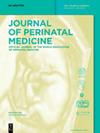早产和胎膜完整患者羊膜腔内感染的多变量预测模型,包括测量羊水 MMP-8 的护理点系统
IF 1.7
4区 医学
Q3 OBSTETRICS & GYNECOLOGY
引用次数: 0
摘要
目的 在早产和胎膜早破(PTL)患者中,羊膜腔内感染(IAI)患者围产期不良结局的风险最高。目前基于微生物培养和/或 16S 核糖体 RNA 基因聚合酶链反应扩增的羊膜腔内感染鉴定延误了诊断,进而延误了产前管理。本研究旨在评估一个多变量预测模型的性能,该模型利用临床、超声和生化生物标志物对 PTL 低于 34.0 周的患者进行 IAI 诊断。方法 从2019年到2022年,我们前瞻性地纳入了34.0周以下、诊断为PTL并接受了羊膜穿刺术以排除IAI的孕妇患者。主要结果是IAI,其定义是羊水培养和/或16S核糖体RNA基因阳性。根据入院日期,样本(n=98)被分为衍生队列(2019-2020年,n=49)和验证队列(2021-2022年,n=49)。针对评估结果建立了逻辑回归模型。作为预测变量,我们探讨了入院时的超声宫颈长度测量、孕产妇C反应蛋白、胎龄、羊水葡萄糖和基质金属蛋白酶-8(MMP-8)水平。该模型在推导队列中建立,并应用于验证队列,同时对诊断性能进行了评估。临床管理对模型结果采取盲法。结果 在研究期间,我们共收治了 98 名诊断为 PTL 的患者。其中 10% 患有 IAI。最终模型包括 MMP-8 和羊水葡萄糖水平,在验证队列中,预测 IAI 风险的接收器操作特征曲线下面积为 0.961(95% 置信区间:0.860-0.995),灵敏度为 75%,特异性为 93.3%,阳性似然比 (LR) 为 11.3,阴性似然比为 0.27。结论 在 PTL 患者中,包括羊水 MMP-8 和葡萄糖水平在内的多变量预测模型可能有助于对接受羊膜腔穿刺术的患者进行临床管理,以排除 IAI,并在几分钟内提供结果。本文章由计算机程序翻译,如有差异,请以英文原文为准。
A multivariable prediction model for intra-amniotic infection in patients with preterm labor and intact membranes including a point of care system that measures amniotic fluid MMP-8
Objectives Among patients with preterm labor and intact membranes (PTL), those with intra-amniotic infection (IAI) present the highest risk of adverse perinatal outcomes. Current identification of IAI, based on microbiological cultures and/or polymerase chain reaction amplification of the 16S ribosomal RNA gene, delay diagnosis and, consequently, antenatal management. The aim to of the study was to assess the performance of a multivariable prediction model for diagnosing IAI in patients with PTL below 34.0 weeks using clinical, sonographic and biochemical biomarkers. Methods From 2019 to 2022, we prospectively included pregnant patients admitted below 34.0 weeks with diagnosis of PTL and had undergone amniocentesis to rule in/out IAI. The main outcome was IAI, defined by a positive culture and/or 16S ribosomal RNA gene in amniotic fluid. Based on the date of admission, the sample (n=98) was divided into a derivation (2019–2020, n=49) and validation cohort (2021–2022, n=49). Logistic regression models were developed for the outcomes evaluated. As predictive variables we explored ultrasound cervical length measurement at admission, maternal C-reactive protein, gestational age, and amniotic fluid glucose and matrix metalloproteinase-8 (MMP-8) levels. The model was developed in the derivation cohort and applied to the validation cohort and diagnostic performance was evaluated. Clinical management was blinded to the model results. Results During the study period, we included 98 patients admitted with a diagnosis of PTL. Of these, 10 % had IAI. The final model included MMP-8 and amniotic fluid glucose levels and showed an area under the receiver operating characteristic curve to predict the risk of IAI of 0.961 (95 % confidence interval: 0.860–0.995) with a sensitivity of 75 %, specificity of 93.3 %, positive likelihood ratio (LR) of 11.3 and negative LR of 0.27 in the validation cohort. Conclusions In patients with PTL, a multivariable prediction model including amniotic fluid MMP-8 and glucose levels might help in the clinical management of patients undergoing amniocentesis to rule in/out IAI, providing results within a few minutes.
求助全文
通过发布文献求助,成功后即可免费获取论文全文。
去求助
来源期刊

Journal of Perinatal Medicine
医学-妇产科学
CiteScore
4.40
自引率
8.30%
发文量
183
审稿时长
4-8 weeks
期刊介绍:
The Journal of Perinatal Medicine (JPM) is a truly international forum covering the entire field of perinatal medicine. It is an essential news source for all those obstetricians, neonatologists, perinatologists and allied health professionals who wish to keep abreast of progress in perinatal and related research. Ahead-of-print publishing ensures fastest possible knowledge transfer. The Journal provides statements on themes of topical interest as well as information and different views on controversial topics. It also informs about the academic, organisational and political aims and objectives of the World Association of Perinatal Medicine.
 求助内容:
求助内容: 应助结果提醒方式:
应助结果提醒方式:


